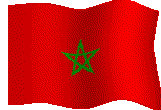 |
1 Mar: Meknes (II) - Imperial City of Moulay Ismail |
 |
1 Mar: Meknes (II) - Imperial City of Moulay Ismail |
A Walk Through Imperial Meknes
I went to the CTM (the newly privatised national bus company) to check for buses to Chefchaouen in the Rif Mountains. None found, and so I went to the Medina's bus station, which is used by private bus companies. Few people at this bus station speak English (unlike CTM's stations around the country, where one can usually find some English speakers) but I was directed to a booth manned by an elderly gentleman who's terribly short sighted and yet doesn't wear any spectacles. He couldn't speak English either, and scribbled some timing on my notebook when I said Chefchaouen. He struggled even to write the numbers in the usual "international" numerals. He wrote initially in Arabic numerals, cancelled them, and then rewriting in some barely readable form. There's a reasonable timing - 9 am - although I wasn't sure if it was going to Chefchaouen, or to some similar-sounding and more exotic destinations in Western Sahara, Mauritania or Mali. Not that I mind going to these places, but I have to get back to London in a few days' time or face the music. To play safe, I decided to get the ticket only the next day, and with Chef written in Arabic.
The bus station is located at Bab el Khamis, with the now familiar high
walls and grand city gates. From there, I walked into the Medina
to visit Bab Mansour, the beautiful and renowned city gate, with its magnificent
green tiles and Quranic phases in exuberant Arabic calligraphy. It's
grand, but pictures and postcards look better. I began exploring
the ancient city of Meknes, also listed as an UNESCO World Heritage site.
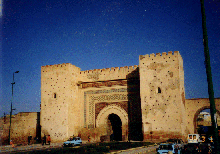 |
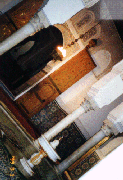 |
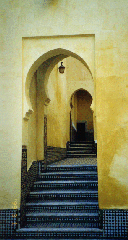 |
|
|
|
|
Meknes' Medina is still a completely walled city, and its walls are,
in my opinion, more magnificent than Fes'. The Medina is surrounded
by miles and miles of walls, and within, there are even more walls with
a smaller but just-as-grand Imperial City. I visited Moulay Ismail's
Mausoleum, also a revered national shrine. Here, one walks into an
empty compound with high, bare yellow walls, and then into another similar
compound. Eventually, one reaches the shrine with its intricate geometric
carvings and the elaborate tomb. Cool for those interested in zen
and that strange thing known in the west as "oriental mysticism".
Exchanges With Yet Another Crook
I continued southwards along the avenue, passing the high walls of (yet another) Royal Palace with its army camp. It was a very long walk, with both sides of the road enclosed by high walls. Eventually, I reached the Heri es-Souani, the old imperial granaries and stables. I walked into the complex - but there weren't anyone at the ticket stand. Suddenly, the ticket-seller rushed in from the same direction as me. This lazy bum was having a chat with his friends outside and they must have told him about the visitor. It's time to get back to work.
"Twenty dirhams," he said.
No way ! All the places I had been cost only DH 10 to enter, and I told him so. "Today is Monday, and it's only DH 10 on weekends," he argued.
"Come on, friend, it's my third week in this country and I know the rules," I rebutted.
"Oh, you are alone ? Yes, it's DH 20 for two persons, and since you are alone, it costs only DH 10." This crooky chap had probably realised that he can't con me, and found an easy way out of the situation.
So, I paid him DH 10, and then asked for the receipt, which he assured, would be passed to me later. Trying to be a little nasty today, I told him: "I'll be back for the ticket. Get ready for it." And then I walked in.
Although bare and dark, the Heri es-Souani is very impressive.
Immense chambers with a few small windows - the granaries once stored enough
food for the imperial army, and its stables accommodate 12,000 horses.
Architectural technology was innovative in those days too, with water circulated
below the floor to keep the place cool. It was dead quiet within,
and one needs a lot of imagination to bring the place alive. Perhaps,
the Moroccan government should turn parts of this complex into a café
and play either traditional or classical music to attract more visitors.
There is certainly a lot one can do with all these empty space. The
only activity that had occurred in modern days, it seems, were the few
movies that were filmed there, years ago. There is a lot to do before
they can transform this into a world class attraction.
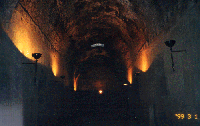 |
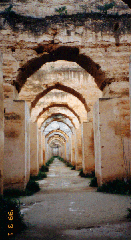 |
|
|
|
Upon that, I returned to the ticket seller, and asked for my receipt. The quick-witted one said, "Have you seen the outdoor stables," pointing to a postcard. No, I said, and he quickly brought me to that place right behind. Wow, the ruins were pretty wild and picturesque - with much vegetation amidst the ruins - and after a few photos, I was back at the ticket stand.
"Have you seen the wells," he said and then ran into the building again. Although I had already seen that, I followed him, thinking that I might have missed something. Well, it was exactly what I had seen earlier, but I decided to let him off by then. After all, he needs to feed his family. In this poor country, people at the very top were siphoning money from the state, and this way of life filters downwards to the ordinary people, who have to find minor ways of getting back at the state in order to survive.
Dinner was at a cheap eating place near the hotel, and I had a nice time chatting with fellow travellers from Down Under.
![]() 2 Mar: Chefchaouen - Marijuana Country Africa
2 Mar: Chefchaouen - Marijuana Country Africa